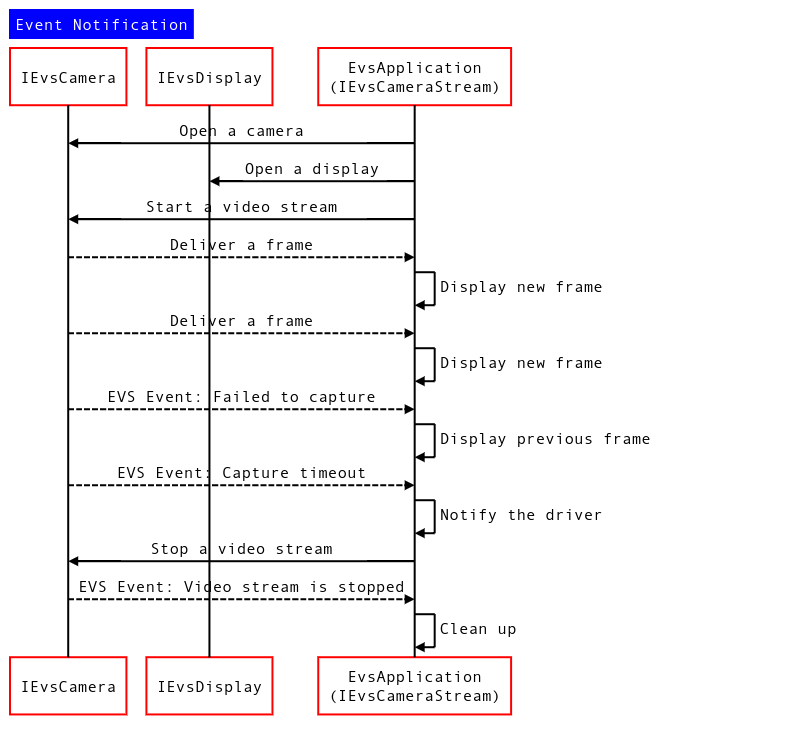前回の車外表示システム(EVS)のリリースでは、IEvsCameraStream インターフェースが、キャプチャされた動画フレームのみを配信する単一のコールバック メソッドを定義していました。これは EVS サービス クライアントの実装を簡素化する一方で、クライアントがストリーミング インシデントを特定し、適切に処理することを困難にしていました。EVS 開発の利便性のため、AOSP にはストリーミング イベントを配信する追加のコールバックが含まれるようになりました。
package android.hardware.automotive.evs@1.1; import @1.0::IEvsCameraStream; /** * Implemented on client side to receive asynchronous video frame deliveries. */ interface IEvsCameraStream extends @1.0::IEvsCameraStream { /** * Receives calls from the HAL each time a video frame is ready for inspection. * Buffer handles received by this method must be returned via calls to * IEvsCamera::doneWithFrame_1_1(). When the video stream is stopped via a call * to IEvsCamera::stopVideoStream(), this callback may continue to happen for * some time as the pipeline drains. Each frame must still be returned. * When the last frame in the stream has been delivered, STREAM_STOPPED * event must be delivered. No further frame deliveries may happen * thereafter. * * @param buffer a buffer descriptor of a delivered image frame. */ oneway deliverFrame_1_1(BufferDesc buffer); /** * Receives calls from the HAL each time an event happens. * * @param event EVS event with possible event information. */ oneway notify(EvsEvent event); };
このメソッドは、次の 3 つのフィールドで構成される EvsEventDesc を提供します。
- イベントのタイプ。
- イベントの発生元を識別する文字列。
- イベント情報を格納する、32 ビット単語データ x 4。
/** * Structure that describes informative events occurred during EVS is streaming */ struct EvsEvent { /** * Type of an informative event */ EvsEventType aType; /** * Device identifier */ string deviceId; /** * Possible additional information */ uint32_t[4] payload; };
さらに、EVS と他の Android グラフィカル コンポーネントとの間のグラフィック バッファの記述にばらつきが生じないよう、android.hardware.graphics.common@1.2 のインターフェースからインポートされた HardwareBuffer を使用するように BufferDesc を再定義しました。HardwareBuffer には HardwareBufferDescription が含まれています。これは、Android NDK の AHardwareBuffer_Desc に対する HIDL の等価物であり、バッファ ハンドルが含まれます。
/** * HIDL counterpart of AHardwareBuffer_Desc. * * An AHardwareBuffer_Desc object can be converted to and from a * HardwareBufferDescription object by memcpy(). * * @sa +ndk libnativewindow#AHardwareBuffer_Desc. */ typedef uint32_t[10] HardwareBufferDescription; /** * HIDL counterpart of AHardwareBuffer. * * AHardwareBuffer_createFromHandle() can be used to convert a HardwareBuffer * object to an AHardwareBuffer object. * * Conversely, AHardwareBuffer_getNativeHandle() can be used to extract a native * handle from an AHardwareBuffer object. Paired with AHardwareBuffer_Desc, * AHardwareBuffer_getNativeHandle() can be used to convert between * HardwareBuffer and AHardwareBuffer. * * @sa +ndk libnativewindow#AHardwareBuffer". */ struct HardwareBuffer { HardwareBufferDescription description; handle nativeHandle; } /** * Structure representing an image buffer through our APIs * * In addition to the handle to the graphics memory, need to retain * the properties of the buffer for easy reference and reconstruction of * an ANativeWindowBuffer object on the remote side of API calls. * (Not least because OpenGL expect an ANativeWindowBuffer* for us as a * texture via eglCreateImageKHR(). */ struct BufferDesc { /** * HIDL counterpart of AHardwareBuffer_Desc. Please see * hardware/interfaces/graphics/common/1.2/types.hal for more details. */ HardwareBuffer buffer; /** * The size of a pixel in the units of bytes */ uint32_t pixelSize; /** * Opaque value from driver */ uint32_t bufferId; /** * Unique identifier of the physical camera device that produces this buffer. */ string deviceId; /** * Time that this buffer is being filled */ int64_t timestamp; /** * Frame metadata. This is opaque to EVS manager */ vec<uint8_t> metadata };
注: HardwareBufferDescription は 32 ビット単語 10 個の配列として定義されます。AHardwareBuffer_Desc 型としてキャストし、その内容を入力できます。
EvsEventDesc は、複数のストリーミング イベントをリストする enum EvsEventType と、デベロッパーが追加情報を格納できる 32 ビット単語のペイロードの構造体です。たとえば、デベロッパーはストリーミング エラーイベントのエラーコードを格納できます。
/** * Types of informative streaming events */ enum EvsEventType : uint32_t { /** * Video stream is started */ STREAM_STARTED = 0, /** * Video stream is stopped */ STREAM_STOPPED, /** * Video frame is dropped */ FRAME_DROPPED, /** * Timeout happens */ TIMEOUT, /** * Camera parameter is changed; payload contains a changed parameter ID and * its value */ PARAMETER_CHANGED, /** * Master role has become available */ MASTER_RELEASED, };
フレーム配信
新しい BufferDesc により、IEvsCameraStream にはフレームとストリーミング イベントをサービス実装から受信する新しいコールバック メソッドも導入されます。
/** * Implemented on client side to receive asynchronous streaming event deliveries. */ interface IEvsCameraStream extends @1.0::IEvsCameraStream { /** * Receives calls from the HAL each time video frames are ready for inspection. * Buffer handles received by this method must be returned via calls to * IEvsCamera::doneWithFrame_1_1(). When the video stream is stopped via a call * to IEvsCamera::stopVideoStream(), this callback may continue to happen for * some time as the pipeline drains. Each frame must still be returned. * When the last frame in the stream has been delivered, STREAM_STOPPED * event must be delivered. No further frame deliveries may happen * thereafter. * * A camera device will deliver the same number of frames as number of * backing physical camera devices; it means, a physical camera device * sends always a single frame and a logical camera device sends multiple * frames as many as the number of backing physical camera devices. * * @param buffer Buffer descriptors of delivered image frames. */ oneway deliverFrame_1_1(vec<BufferDesc> buffer); /** * Receives calls from the HAL each time an event happens. * * @param event EVS event with possible event information. */ oneway notify(EvsEventDesc event); };
フレーム コールバック メソッドの新しいバージョンは、複数のバッファ記述子を処理するように設計されています。したがって、EVS カメラの実装では、複数のソースを管理する場合、1 回の呼び出しで複数のフレームを転送できます。
また、null フレームの送信でストリームの終了を通知する以前のプロトコルは非推奨になり、STREAM_STOPPED イベントに置き換わりました。

図 1. イベント通知シーケンスの図
イベントとフレームの通知メカニズムの使用
クライアントによって実装された IEvsCameraStream のバージョンの特定
このサービスでは、ダウンキャストを試行して、クライアントが実装した受信 IEvsCameraStream インターフェースのバージョンを識別できます。
using IEvsCameraStream_1_0 = ::android::hardware::automotive::evs::V1_0::IEvsCameraStream; using IEvsCameraStream_1_1 = ::android::hardware::automotive::evs::V1_1::IEvsCameraStream; Return<EvsResult> EvsV4lCamera::startVideoStream( const sp<IEvsCameraStream_1_0>& stream) { IEvsCameraStream_1_0 aStream = stream; // Try to downcast. This will succeed if the client implements // IEvsCameraStream v1.1. IEvsCameraStream_1_1 aStream_1_1 = IEvsCameraStream_1_1::castFrom(aStream).withDefault(nullptr); if (aStream_1_1 == nullptr) { ALOGI("Start a stream for v1.0 client."); } else { ALOGI("Start a stream for v1.1 client."); } // Start a video stream ... }
notify() コールバック
EvsEvent は notify() コールバックを通じて渡されます。クライアントは以下のように、弁別子に基づいてタイプを識別できます。
Return<void> StreamHandler::notify(const EvsEvent& event) { ALOGD("Received an event id: %u", event.aType); // Handle each received event. switch(event.aType) { case EvsEventType::ERROR: // Do something to handle an error ... break; [More cases] } return Void(); }
BufferDesc の使用
AHardwareBuffer_Desc は、EGL/OpenGL と Vulkan プリミティブにバインドできるネイティブ ハードウェア バッファを表す Android NDK のデータ型です。これには以前の EVS BufferDesc のバッファ メタデータのほとんどが含まれているため、新しい定義の BufferDesc に置き換わります。ただし、これは HIDL インターフェースの配列として定義されているため、メンバー変数を添え字で直接操作することはできません。代わりに、次のように、配列を AHardwareBuffer_Desc の型としてキャストできます。
BufferDesc bufDesc = {}; AHardwareBuffer_Desc* pDesc = reinterpret_cast<AHardwareBuffer_Desc *>(&bufDesc.buffer.description); pDesc->width = mVideo.getWidth(); pDesc->height = mVideo.getHeight(); pDesc->layers = 1; pDesc->format = mFormat; pDesc->usage = mUsage; pDesc->stride = mStride; bufDesc_1_1.buffer.nativeHandle = mBuffers[idx].handle; bufDesc_1_1.bufferId = idx;
